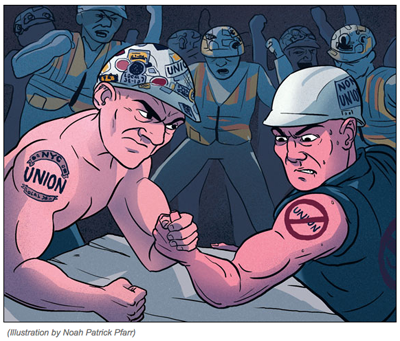 Those sounds you hear are the screams of agony emanating from the labor unions in the construction industry in New York City. For the first time in recent history, three major contractors, Turner, Tishman and Plaza Construction have joined with several lesser-known companies to open their private sector sites to non-union labor.
Those sounds you hear are the screams of agony emanating from the labor unions in the construction industry in New York City. For the first time in recent history, three major contractors, Turner, Tishman and Plaza Construction have joined with several lesser-known companies to open their private sector sites to non-union labor.
This is a move that, in the recent past, would not have been considered on commercial and residential projects in New York, long a hotbed of union labor in the construction unions. This is an especially critical change in a market like New York City where densities and construction rules for both public and private sector projects have long mandated that construction workers on the major sites must have apprentice training in order to be employed.
According to a recent article in the Wall Street Journal titled “Construction Unions’ Grip on New York Begins to Show Cracks” states that the major construction firms have declined “to renew collective bargaining agreements with unions, opening the door for more non-union workers and sending the clearest signal yet that once mighty construction trade groups are losing their grip on private-sector construction work.”
Many of the contractors are becoming “open shop,” using a mix of union and non-union workers on their projects. This movement is echoed in a recent article in therealdeal.com that asks the question, “Are the Unions Losing Their Grip in NYC?“ Why has this happened? According to the WSJ, developers who use solely union labor find that their costs are 20-30% higher than when they are “open-shop.” The “low cost” model that emerged during the downturn is becoming the norm in NYC, and those companies who have been strictly union shop will have to find a new model if they want to compete as the economy recovers.
The arguments have become heated with the unions quoting recent impact studies such as one published by the Illinois Public Policy Institute and Smart Cities Prevail claiming that workers are not being paid a living wage and that low safety standards on “open shop” projects lead to more injuries, poorer quality workmanship and many workers struggling to maintain their businesses. The developers, on the other hand, claim that “open-shop” firms can perform as well at a lower price even when they provide benefits for their workers.
The developers also claim that the unions have been slow to upgrade their training and technology and that non-union subs are adapting faster in order to be more productive and to compete.
This is a phenomenon in the major cities of the US that bears watching, especially as the economy recovers and the skilled labor shortages hit those construction markets.
At the same time, the public sector projects in New York City and most of the other major cities are still mainly union jobs and it appears that they will remain union shop for the foreseeable future. Some critics are beginning to wonder why the public is required to pay 20-30% more for the institutional construction when the private sector is quickly moving to a new model. We have not heard the last of these arguments, especially in this election year.


